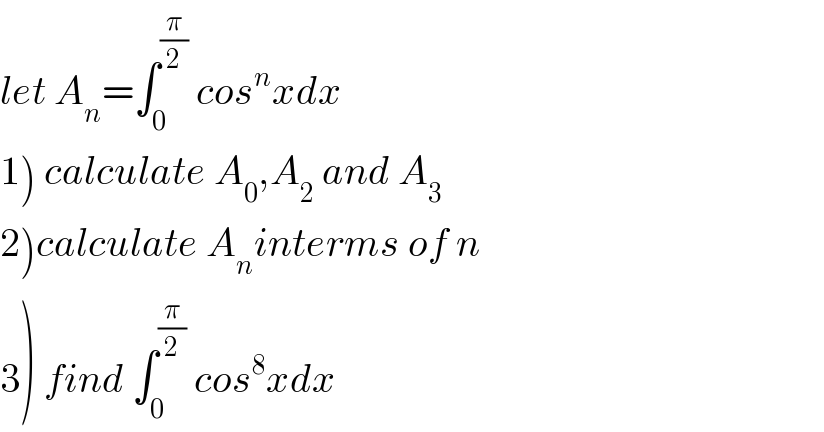
Question Number 65770 by mathmax by abdo last updated on 03/Aug/19

$${let}\:{A}_{{n}} =\int_{\mathrm{0}} ^{\frac{\pi}{\mathrm{2}}} \:{cos}^{{n}} {xdx} \\ $$$$\left.\mathrm{1}\right)\:{calculate}\:{A}_{\mathrm{0}} ,{A}_{\mathrm{2}} \:{and}\:{A}_{\mathrm{3}} \\ $$$$\left.\mathrm{2}\right){calculate}\:{A}_{{n}} {interms}\:{of}\:{n} \\ $$$$\left.\mathrm{3}\right)\:{find}\:\int_{\mathrm{0}} ^{\frac{\pi}{\mathrm{2}}} \:{cos}^{\mathrm{8}} {xdx}\: \\ $$
Commented by ~ À ® @ 237 ~ last updated on 04/Aug/19
![A_0 =[x]_0_ ^(π/2) =(π/2) 2A_n = 2∫_0 ^(π/2) (sinx)^(2((1/2))−1) (cosx)^(2(((n+1)/2))−1) dx=B((1/2). ((n+1)/2)) Then A_n = (1/2). ((Γ((1/2))Γ(((n+1)/2)))/(Γ(((n+2)/2)))) when using the Lagrange formula Π_(k=1) ^(p−1) Γ(z+(k/p))=(2π)^((p−1)/2) p^((1/2)−pz) Γ(pz) Γ(n+(1/2))=(√(π )) ((Γ(2n))/2^(2n−1) ) ∀ n>1 so we can find A_(2n) = ((√π)/2).((((√π) Γ(2n))/2^(2n−1) )/(Γ(n+1)))= (((2n−1)!)/(2^(2n) n!)) π A_(2n+1) = ((√π)/2). ((Γ(n+1))/((√π) .((Γ(2n+2))/2^(2n+1) )))=((2^(2n) .n!)/((2n+1)!)) So A_1 =1 A_3 = ((2^2 .1!)/(3!)) A_8 =((7!π)/(2^8 4!))](Q65821.png)
$$\:{A}_{\mathrm{0}} =\left[{x}\right]_{\mathrm{0}_{} } ^{\frac{\pi}{\mathrm{2}}} =\frac{\pi}{\mathrm{2}} \\ $$$$\mathrm{2}{A}_{{n}} \:=\:\mathrm{2}\int_{\mathrm{0}} ^{\frac{\pi}{\mathrm{2}}} \left({sinx}\right)^{\mathrm{2}\left(\frac{\mathrm{1}}{\mathrm{2}}\right)−\mathrm{1}} \left({cosx}\right)^{\mathrm{2}\left(\frac{{n}+\mathrm{1}}{\mathrm{2}}\right)−\mathrm{1}} {dx}={B}\left(\frac{\mathrm{1}}{\mathrm{2}}.\:\:\frac{{n}+\mathrm{1}}{\mathrm{2}}\right) \\ $$$${Then}\:{A}_{{n}} \:=\:\frac{\mathrm{1}}{\mathrm{2}}.\:\frac{\Gamma\left(\frac{\mathrm{1}}{\mathrm{2}}\right)\Gamma\left(\frac{{n}+\mathrm{1}}{\mathrm{2}}\right)}{\Gamma\left(\frac{{n}+\mathrm{2}}{\mathrm{2}}\right)} \\ $$$${when}\:{using}\:{the}\:{Lagrange}\:{formula}\:\underset{{k}=\mathrm{1}} {\overset{{p}−\mathrm{1}} {\prod}}\Gamma\left({z}+\frac{{k}}{{p}}\right)=\left(\mathrm{2}\pi\right)^{\frac{{p}−\mathrm{1}}{\mathrm{2}}} {p}^{\frac{\mathrm{1}}{\mathrm{2}}−{pz}} \Gamma\left({pz}\right) \\ $$$$\Gamma\left({n}+\frac{\mathrm{1}}{\mathrm{2}}\right)=\sqrt{\pi\:}\:\frac{\Gamma\left(\mathrm{2}{n}\right)}{\mathrm{2}^{\mathrm{2}{n}−\mathrm{1}} }\:\:\forall\:{n}>\mathrm{1} \\ $$$${so}\:{we}\:{can}\:{find}\: \\ $$$${A}_{\mathrm{2}{n}} =\:\frac{\sqrt{\pi}}{\mathrm{2}}.\frac{\frac{\sqrt{\pi}\:\Gamma\left(\mathrm{2}{n}\right)}{\mathrm{2}^{\mathrm{2}{n}−\mathrm{1}} }}{\Gamma\left({n}+\mathrm{1}\right)}=\:\frac{\left(\mathrm{2}{n}−\mathrm{1}\right)!}{\mathrm{2}^{\mathrm{2}{n}} \:{n}!}\:\pi \\ $$$${A}_{\mathrm{2}{n}+\mathrm{1}} =\:\frac{\sqrt{\pi}}{\mathrm{2}}.\:\frac{\Gamma\left({n}+\mathrm{1}\right)}{\sqrt{\pi}\:.\frac{\Gamma\left(\mathrm{2}{n}+\mathrm{2}\right)}{\mathrm{2}^{\mathrm{2}{n}+\mathrm{1}} }}=\frac{\mathrm{2}^{\mathrm{2}{n}} .{n}!}{\left(\mathrm{2}{n}+\mathrm{1}\right)!} \\ $$$${So}\:\:\:{A}_{\mathrm{1}} =\mathrm{1}\:\:\:\:\:\:{A}_{\mathrm{3}} =\:\frac{\mathrm{2}^{\mathrm{2}} .\mathrm{1}!}{\mathrm{3}!}\:\:\:\:\:\:{A}_{\mathrm{8}} =\frac{\mathrm{7}!\pi}{\mathrm{2}^{\mathrm{8}} \mathrm{4}!}\:\: \\ $$
Commented by mathmax by abdo last updated on 04/Aug/19

$${thank}\:{you}\:{sir}. \\ $$
